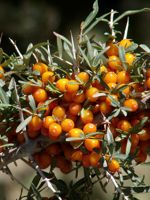Mon-Fri 9am - 5pm Mountain time
Black Elderberry vs Orange Energy Sea Buckthorn (Female)
Sambucus canadensis
Hippophae rhamnoides Orange Energy
NOT AVAILABLE THIS SEASON - MIGHT RETURN
Black Elderberry is a deciduous shrub native to eastern North America. You can plant this shrub in moist areas and it will help stabilize your soil. You can also use it on rural properties anywhere you'd use a lilac.
Black Elderberries are considered to be partially self-pollinating. So while they will still produce some berries without cross-pollination, planting with another variety will increase yields. Consider planting with Ranch Elderberry or Bob Gordon Elderberry.
Warning: the seeds, stems, leaves, roots, and uncooked berries of the Black Elderberry are poisonous to humans when eaten in quantity. You should cook the berries to make them safe for human consumption.
Orange Energy Sea Buckthorn is a female variety known for its large yields of yellowish orange berries that ripen in September. The berries are juicy with a pleasant tart flavour. They have a high sugar content and are often sought after for their vitamin C concentration. Orange Energy Sea Buckthorn requires a male pollinizer to set fruit.
Orange Energy Sea Buckthorn has moderately thorny branches and other well-known features of Sea Buckthorn plants. These include silvery green foliage and nitrogen-fixing capabilities, which improves the surrounding soil.
Sea Buckthorn plants have male and female flowers occurring on different plants, a male pollinizer is required for fruit production. Can be paired with Lord Sea Buckthorn which is a male variety.
Black Elderberry Quick Facts
Orange Energy Sea Buckthorn (Female) Quick Facts
Toxicity: leaves, stems, and uncooked berries are poisonous to humans

